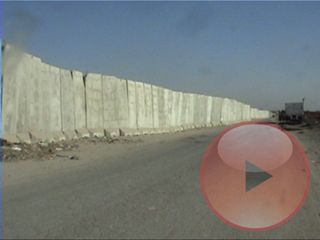Baghdad Walls Divide Neighbors, Friends

Produced by Nabeel Kamal
BAGHDAD, IRAQ– In order to reduce the rate of violence between the Ghazaliya neighborhood and the Shu’la neighborhood, the Iraqi Government and Coalition Forces built a wall to separate these two neighborhoods. The Iraqi Government initially opposed construction of the walls, but later relented when the US and Iraq’s own Defense Minister made it clear that construction would continue. This was to prevent infiltration by insurgents and traveling between the two neighborhoods and planting IEDs and assassinating people from the opposing sect.
The wall is one and a quarter miles long, measuring from the northern to the southern side of the two neighborhoods and the height of the wall is approximately three meters.
Some rejection demonstrations was taking place around the Wall describing it as another method to separate the Iraqi society, and the crowed was contains both Sunni and Shia Iraqis
Ghazaliya is considered as an expensive neighborhood for Sunni Iraqis, and Shu’la is considered an expensive neighborhood, primarily for Shi’a Iraqis. In Ghazaliya you can see a large building called the Muslim Scholar’s Association which is the head of the Sunni Organizations all across Iraq. On the other side of the wall, in Shu’la there are several offices for the Sadr Movement.
In 2006 Ghazaliya was considered one of the most dangerous neighborhoods in Baghdad, due to a high number of assassination and kidnapping operations that were taking places on both sides of Ghazaliya, the first side is near the Baghdad highway and the other side marks the border with the Shu’la neighborhood. Then mortar attacks became something very normal between the two neighborhoods, many Iraqis were killed by these attacks. Some people living in the two neighborhoods claimed that either Al-Qaeda or Shi’a extremists in Ghazaliya or Shu’la respectively, were responsible for those attacks. These witness claim they were not caused by regular people who lived in the neighborhoods.
On September 11, 2007 hundreds of people participated in demonstrations calling for an end to building the wall in between the two communities. Similar demonstrations occurred in Adhamiya previous to the construction of the wall in Ghazaliya, as we have shown previously. Today the walls still stand, and it is unclear when or if they will be removed. Although Baghdad appears safer, it is only as a city divided.
archival reference: https://web.archive.org/web/20130706034815/http://aliveinbaghdad.org/2008/02/04/baghdad-walls-divide-neighbors-friends/
Editor's Note: The concept for Alive-in/ began in 2005 with the launch of Alive in Baghdad. Many of the stories produced by our team of Iraqi reporters were taken offline with the closure of blip.tv.
In remembrance of the 20th anniversary of the United States war against Iraq, we are republishing as much of Alive in Baghdad's original content as possible here on Alive-in/. Each story has been given its original date so that these posts don't overwhelm our current stories, and tagged as relevant.
